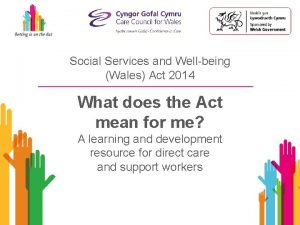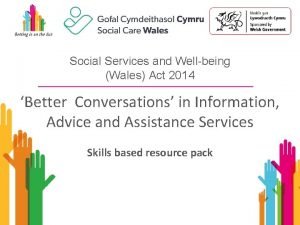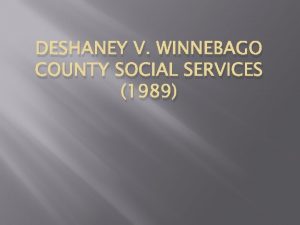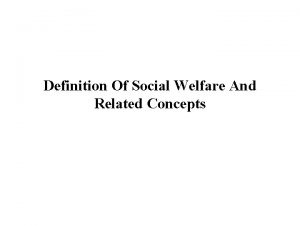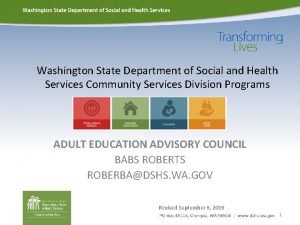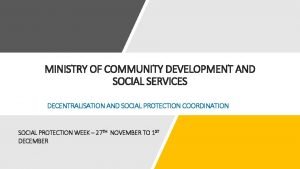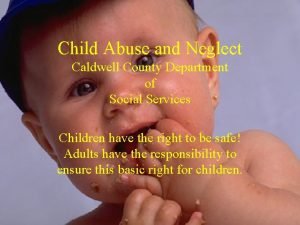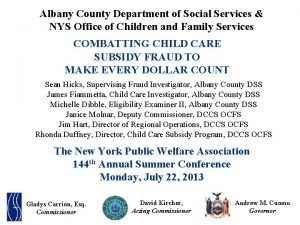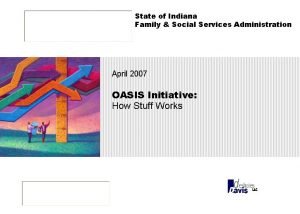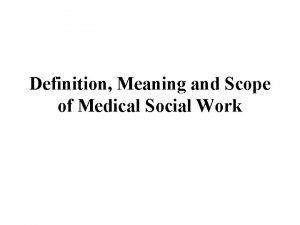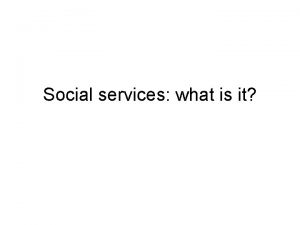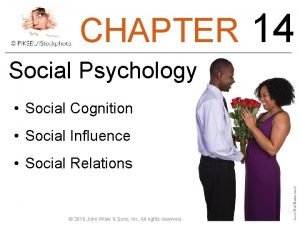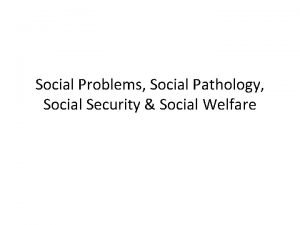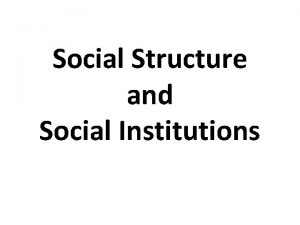Social services what is it Social services in




















- Slides: 20

Social services: what is it?

Social services – in the news • • • Impact of increasing elderly population Impact of medical advances Arrival of asylum seekers Enough money in the system? Should we pay for residential care? Scandals – Baby P/Laming inquiry/Victoria Climbie

Social services: who for? • • • Elderly Disabled Children at risk Mentally ill Long-term ill Anyone “vulnerable” – asylum seekers

Social services: who provides? Social care – “multi agency approach” – often more than one provider involved. These can be: Local authorities (social services providers are counties; unitaries; London boroughs) Health bodies – Primary Care Trusts The Police (children at risk/abuse issues) Education authorities Charitable groups eg NSPCC

Community Care • NHS and Community Care Act 1990: shifted responsibility from NHS to local govt. • Aim: to move away from institutional living to independent living • Care is provided for problems associated with: • Ageing • Mental illness • Learning difficulties • Physical/sensory impairments • NHS+Social services required to make Partnership Arrangements for care

Community Care: How it works • Anyone with disability or any other social care need is entitled to an assessment: • Old age/physical weakness • Physical difficulties • Sensory difficulties • Learning disabilities • Mental health problems

Community care: how? • Assessments gauge what kind of help might be needed and can be provided in accordance with “eligibility criteria. ” • Councils usually have a system that grades level of need: for example, critical, substantial, moderate or low • People most at risk given priority • Individuals are given a care plan setting out what will be provided and by who

Community care – what kind of care? • • • Domiciliary care services: such as – Meals on wheels Help with personal bathing Respite care Special equipment added to home – ramps; adapted furniture; stair rails • Services often contracted out to private sector/voluntary sector. Charges can be made; often free

Community care – other help • Support for deaf and blind • Day care services – organise activities for people • Recuperative and intermediate care services: short-term (few weeks) and intensive help to help recovery after illness; fal or other crisis. May be at a care home • Respite care for carers, who may themselves need help (such as a break or holiday) • Residential care in home – often bought in by council but how much is paid subject to means-testing

Growing pressure • We are an ageing society – people now living much longer than they were + have high expectations of what care they should get • More people over 65 than under 16 for the first time • Fastest growing sector of the population is the over-80 s • In 1900, 1% of popn. was > 65; 2000 it was 7%; by 2050, it will be 20%

Children’s Services • Protecting at risk children one of most important jobs of social services (Laming scandal) • Safeguarding children is overseen by Local Safeguarding Childrens Boards (prev. Area Child Protection Committees) • These came in under Children’s Act 2004 (post. Laming inquiry) • Act also established Children’s Services Departments for local councils – bringing education and social care for children together

Children taken into care – why? • Two main reasons: • Children who are subject to a care order made by courts under Section 31 of Chilren’s Act • Children accommodated by local authority on voluntary basis under Section 20 (Tracy Beaker!)

Care Orders • • • Only for children under 17 Applications for such orders go to Family Proceedings Court (normally Mags Court) Orders are made where: Child is at risk of significant harm and care is below reasonable parental standard

Care Orders • Social services assume parental responsibility but parents must have reasonable access • Interim care orders: where council is seeking full care order. Last maximum of eight weeks, unless court grants renewal

Supervision Orders • Where child is placed under supervision, with councils having a lesser duty to “advise, assist and befriend. ” • Families must be allowed to bring up child if possible • Can be made for abandoned/lost children

Emergency Protection Orders • Where child is deemed to face an immediate danger and harm • Made by courts • Last up to 8 days • Can be extended by court if satisfied risk still exists • Parents can challenge after 72 hours

Care Homes • Councils must provide Community Homes for children in care • Private homes must be registered by the Commission for Social Care Inspection (CSCI)

Fostering • Foster parents: no legal custody or full parental rights • Must be approved by social services • Are paid+have allowances for clothing/holidays etc

Adoption • Eligible children must be < 18 • And be a child for whom returning home is not possible • Adoption orders sever all legal ties with natural birth family • Confers parental rights and responsibilities on new adopting family • Birth parents lose legal rights/cannot take child back

Adoption ii • Adoptive parents must be > 21 • Be able to provide stable + permanent home • Need not be married; can be single; same sex couples can adopt • No upper age limit • No bar against those who are disabled adopting • Adoption must be through an approved Adoption Agency or Voluntary Adoption Society approved by Secy. Of State
 Social thinking and social influence
Social thinking and social influence Social thinking social influence social relations
Social thinking social influence social relations Integrated services vs differentiated services
Integrated services vs differentiated services Wake county human services community services center
Wake county human services community services center Mash safeguarding hub
Mash safeguarding hub Svq social services
Svq social services Social services and wellbeing act easy read
Social services and wellbeing act easy read Social services and wellbeing (wales) act 2014 easy read
Social services and wellbeing (wales) act 2014 easy read Deshaney v winnebago county social services
Deshaney v winnebago county social services What is social welfare
What is social welfare Washington state department of social and health services
Washington state department of social and health services Ministry of community development and social services
Ministry of community development and social services Hnc social services graded unit
Hnc social services graded unit Herefordshire social services
Herefordshire social services Cass community social services
Cass community social services Caldwell county child protective services
Caldwell county child protective services Albany county department of social services
Albany county department of social services Walsall council social services
Walsall council social services Indiana family and social services administration
Indiana family and social services administration Social integration
Social integration Scope of medical social work pdf
Scope of medical social work pdf






